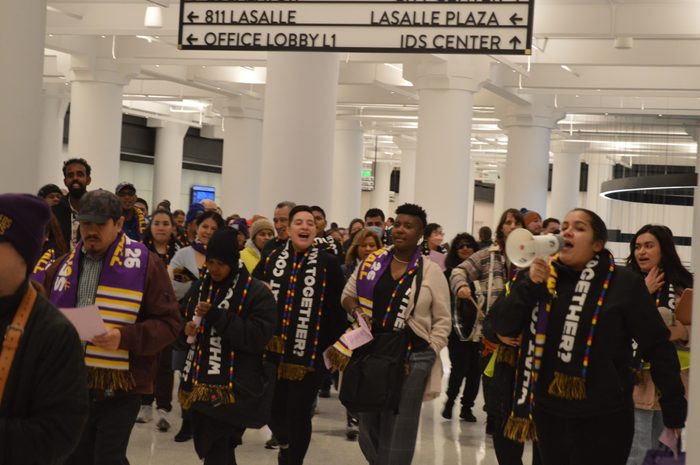They Clean After Holiday Shoppers. But They Don't Get to Celebrate with Their Families.
“In my culture, Christmas Eve is our day to celebrate. ... And I’m going to work like it’s a regular day. It’s hard on the kids.”
Sarah Lazare

Lea este artículo en Español.
For Elbida Gomez, the winter holiday season is not marked by cheer or family time, but by an exponential increase in her workload — cleaning bathrooms and store offices, taking out the trash, mopping entrances and wiping up food from the floor of the employee cafeteria.
The 43-year-old mother of two says she is one of just two people whose primary job is to clean the Woodbury, Minn., location of Cabela’s, a big box store chain that sells hunting, fishing and camping goods. Foot traffic increases as patrons do their holiday shopping. Parents line up with their children to take a photograph with Santa Claus. The floor gets covered in chocolate, candy wrappers and footprints, and, once the snow comes, the store entrance is perpetually coated in salt and sand, she says.
“There is little time and a lot of work,” says Gomez, who has done janitorial work since she moved to the United States from Honduras around 15 years ago.
But in a sector where she is — quite literally — tasked with sanitizing the holiday experiences of other families, she is denied the opportunity to relax and rejuvenate with her own. Gomez does not get paid holidays from her employer, Carlson Building Maintenance, which is contracted to clean Cabela’s. Her vacation time is paltry, she says, and management has made it clear that she is discouraged from taking consecutive days off during the holiday crunch, when her labor is needed most. While her store is closed on Christmas, she does not get paid for this holiday, she says. And, crucially, she still has to work on Christmas Eve, despite its central importance to her family.
“In my culture, Christmas Eve is our day to celebrate. It’s a coming-together period where we make food, have family over and spend time together,” she says over Zoom, with the help of an interpreter. “And I’m going to work like it’s a regular day. It’s hard on the kids.”

Gomez is one of 700 Minnesota janitors for big box or retail stores negotiating a new union contract with SEIU Local 26. Her current one, which expires February 28, 2024, does not include any guaranteed paid holidays or sick days. Woodbury, where she works and lives, falls outside of nearby sick leave protections, and a new statewide law that requires employers to provide certain paid sick time for Minnesota workers (excluding independent contractors) won’t go into effect until January 1. She can earn vacation days, but for the first four years, accrual is relatively slow, at just 40 paid hours annually. And then there is the issue of actually taking those days: “The problem with using vacation days is they often won’t allow us to take vacation days,” Gomez says. This is despite the fact that she works 6.5-hour shifts, six days a week, with only Mondays off, making just $15.30 an hour.
As a result, in the 18 months she has been a cleaner for Cabela’s, Gomez says she has not had a real vacation — meaning multiple consecutive days off in a row.
Research shows that working long weeks with no consecutive days off is hard on workers’ health. One study, published in 1992, examined questionnaires filled out by women over a 20-year period. It found that those who went on vacation once every six years were eight times more likely to develop heart disease or have a heart attack than women who vacationed twice a year. Another study, published in 2000, found that, for middle-aged men who are at higher risk for coronary heart disease, taking more annual vacations is associated with a reduced risk of death by any cause, including heart problems.
The mental health downsides of working without vacation are also well-established. A study published in 2013 looked at the monthly prescription of antidepressants in Sweden, where it’s typical for workers to take off the entire month of July. It found that during those periods when the number of vacationing workers increased, the disbursal of antidepressants declined significantly.
“Especially if it’s unanticipated, but even if it’s anticipated, working long days or consecutive days without the ability to take off work creates mental and physical wear and tear,” explains Lonnie Golden, professor of economics and labor-human resources at Pennsylvania State University. This applies, especially to jobs that are “physically taxing,” he says. “Low-wage work is not compensated by perks, so it’s adding insult to injury — literally.”
At a November 21 press conference over Zoom, Gomez’s fellow union members expressed resentment at the lack of paid holidays. David Citro is a member of SEIU Local 26 and a janitor for Carlson Building Maintenance, who cleans a Cub grocery store in Minneapolis. “During the pandemic times, we were called essential workers,” he said. “It didn’t matter how dangerous it was during those times. We had to be present there at the stores doing our cleaning. Even during those times, we never got recognized or paid or given any holidays with pay.”
Deyanira Rodriguez, a cleaner for Carlson Building Maintenance on special projects, said, “During my time as a kid, it was so wonderful to welcome Christmas Eve with a very warm heart with our families. I would like to be able to offer that to our kids.”
Carlson Building Maintenance did not respond to a request for comment sent to its general informational email, which was followed up by a call to its human resources department. The press department for Bass Pro Shops, which acquired Cabela’s in 2017, referred all questions to Carlson Building Maintenance.
The United States is the only country with an advanced economy that does not have a national guarantee for paid holidays or vacations, and the meager state protections that do exist come nowhere near filling the gap. The United States also doesn’t guarantee paid sick, parental or bereavement leave or any paid time off at all on a national level, though a recently reintroduced piece of federal legislation called the Healthy Families Act would, if passed, make some modest changes to this status quo. Nearly one in four workers in the United States don’t get any paid holidays or paid vacation, according to a May 2019 report from the Center for Economic and Policy Research (CEPR), a left-leaning think tank.
And of those who do receive such days, standards can be fairly low. The CEPR report notes that “the average worker in the private sector receives only 10 paid vacation days and six paid holidays a year, which is far less than in almost every advanced economy except Japan.”
Those who do receive such benefits are more likely to be higher-paid workers. As of March 2022, 95% of the highest-paid 10% of U.S. workers in private industry received paid holidays, while just 46% of the lowest-paid 10% did, according to the Bureau of Labor Statistics. As a result, some workers go years, decades — and even their entire careers — without a single paid holiday. And for workers who are not Christian, it’s common for religious holidays to fall outside of the scant protections that do exist.
For Gomez, it’s not just paid holidays she yearns for, but weekends so that she can spend time with her kids, who are in school all day during the week. Her youngest loves “everything around astronauts,” she says, and the oldest is “way into dinosaurs.” Each of their rooms is decorated in these respective themes. Gomez’s aunt lives with her and watches her kids when she’s working.
Gomez is frustrated she doesn’t get more family time, but she’s not hopeless. As a union steward and a member of the bargaining committee, she is actively trying to improve her working standards. The retail janitors she is bargaining alongside got their first contract in 2017. Their unionization was preceded by a community campaign against wage theft and labor abuse in the janitorial sector, spearheaded by Centro de Trabajadores Unidos, a workers’ center. SEIU Local 26 is pressing for the next contract to ensure eight paid holidays, more vacation days, more affordable healthcare and improved wages. “Holidays for the people who make our holidays happen is an important piece that we need to see improved in this round of negotiations, but it’s not the only issue,” said SEIU Local 26 president Greg Nammacher at the November 21 press conference.

Gomez is also part of a multisectoral effort within Minnesota to address issues that affect workers across unions. For more than a decade, a host of unions have been coordinating to have expired contracts in the spring of 2024, a development that would legally allow them to strike at the same time, or to simply use the threat of a strike as leverage to win joint demands that help all their members. These unions span industries: They include the St. Paul Federation of Educators (SPFE) Local 28; the Minneapolis Federation of Teachers (MFT) Local 59; SEIU Local 284 (which represents support staff); the Amalgamated Transit Union (ATU) Local 1005; SEIU Local 26; and SEIU Healthcare Minnesota & Iowa (nursing home workers). Some of these unions will see their contracts expire in early 2024, while others are working under expired contracts already, making them well-positioned for a potential joint escalation in the spring. And in total, at least 13 unions, workers’ centers and community groups have agreed to support joint mobilization around shared demands.
Gomez and her coworkers are part of this broader push. All of SEIU Local 26, which represents 8,000 members total, voted to endorse a unity statement calling for good jobs, safe staffing and a “strong union.” Among them are 4,000 commercial office janitors who are under a separate contract, which will expire on December 31. The union also endorsed a series of community demands for safe and affordable housing, environmental improvements like well-funded transit, and good schools, including improved funding and smaller class sizes. These demands were developed in concert with other unions, and workers hope that joint pressure will help achieve these broad goals.
Gomez was one of numerous workers who gathered on October 7 at the Marriott hotel inside of the Mall of America to discuss building unity and solidarity around this joint pressure point. “I was there; there were unions from all over the state,” she says. “We are very much in that. We’re in it because we want to make sure we’re heard.”
Gomez says her union’s bargaining fight, and the larger state-wide battle it is part of, have real stakes for her life.
When asked what she would do with more free time, Gomez talks about outings with her children. “During the summer, we love going to the park together, going out somewhere to eat,” she says. “During the winter, we like to go to the mall and walk around together. More than anything, it’s just an excuse to just spend time together. Unfortunately, we don’t have that choice.”
“We have lives, and it’s not just work, work, work. For me, family is the most important, so we need this change.”
This article is a joint publication of In These Times and Workday Magazine, a non-profit newsroom devoted to holding the powerful accountable through the perspective of workers.
Sarah Lazare is the editor of Workday Magazine and a contributing editor for In These Times. She tweets at @sarahlazare.








